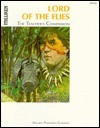
Lord of the Flies
Book Description
Stranded on a deserted island, a group of boys descends into chaos as innocence is stripped away and primal instincts take hold. As they struggle to establish order, alliances form and rivalries erupt, revealing the darkness lurking within human nature. With fear as their guiding force, friendships fracture and morality blurs, pushing the boys to the brink of savagery. Tensions rise and danger lurks around every corner, threatening to consume them all. Will they find a way to restore civilization, or will the island become their grave? What happens when the thin veneer of society shatters?
Quick Book Summary
"Lord of the Flies" by William Golding tells the story of a group of British boys stranded on an uninhabited island after their plane crashes during a wartime evacuation. Initially, they attempt to create a civilized society, electing Ralph as their leader and establishing rules. However, the struggle for power, led by Jack, and the boys' growing fear of a supposed "beast" causes divisions and the breakdown of order. As their attempts at governance collapse, primal instincts take over, leading to violence, loss of innocence, and tragedy. The novel explores the thin veneer of civilization and the darkness inherent in human nature, ultimately questioning whether society can restrain mankind's inherent savagery.
Summary of Key Ideas
Table of Contents
The Fragility of Civilization
A group of British schoolboys is stranded on a remote island after their plane crashes during a wartime evacuation. With no adults present, the boys must fend for themselves. Ralph, one of the older boys, is elected leader and emphasizes the importance of building shelters, keeping a signal fire burning for rescue, and maintaining order. Piggy, the intellectual outsider, becomes Ralph's adviser but is often marginalized. From their earliest days on the island, the boys attempt to recreate the familiar structures of society. However, establishing and maintaining order proves difficult amidst their fears and individual desires.
Innocence and the Loss Thereof
As time passes, fear spreads among the boys, especially concerning a mythical "beast" that some claim to have seen on the island. This fear is manipulated by Jack, head of the choirboys and Ralph’s rival, who forms his own tribe focused on hunting and primal indulgence. Jack’s charisma and promises of safety from the beast attract followers, causing further division. The fire, initially a symbol of hope for rescue, becomes neglected as Jack’s group pursues hunting and ritual, displaying the group's shifting priorities away from civilization.
The Nature of Leadership and Power
The boys' descent into savagery accelerates as reason and order erode. Ralph and Piggy desperately cling to the rules and hope for rescue, but they are outnumbered and overpowered by Jack’s hunters, who are driven by bloodlust and superstition. The fear of the beast transforms into a collective mania, culminating in the frenzied killing of Simon, who tries to reveal the truth – that the beast is not real, but a manifestation of their inner darkness. Piggy is soon killed as well, his death symbolizing the final destruction of wisdom and rationality on the island.
Fear as a Catalyst for Chaos
By the climax, the distinctions between civilization and savagery have dissolved. Jack’s tribe, painted and wild, hunt Ralph, intending to kill him. The boys set the island ablaze to flush Ralph out, destroying their only means of sustenance and safety. In a moment of despair and chaos, the group is discovered by a naval officer who has landed on the island due to the smoke. The boys, realizing the enormity of their actions, are rescued but traumatized, their innocence lost forever.
Innate Human Savagery
"Lord of the Flies" is a profound exploration of human nature, examining how fear, power, and the struggle for survival expose the darkness within. Golding illustrates that, absent the constraints and expectations of society, individuals can regress to primal and violent behavior. The story ends on a somber note, raising unsettling questions about the nature of humanity and the thin boundaries that separate order from anarchy.
Download This Summary
Get a free PDF of this summary instantly — no email required.





